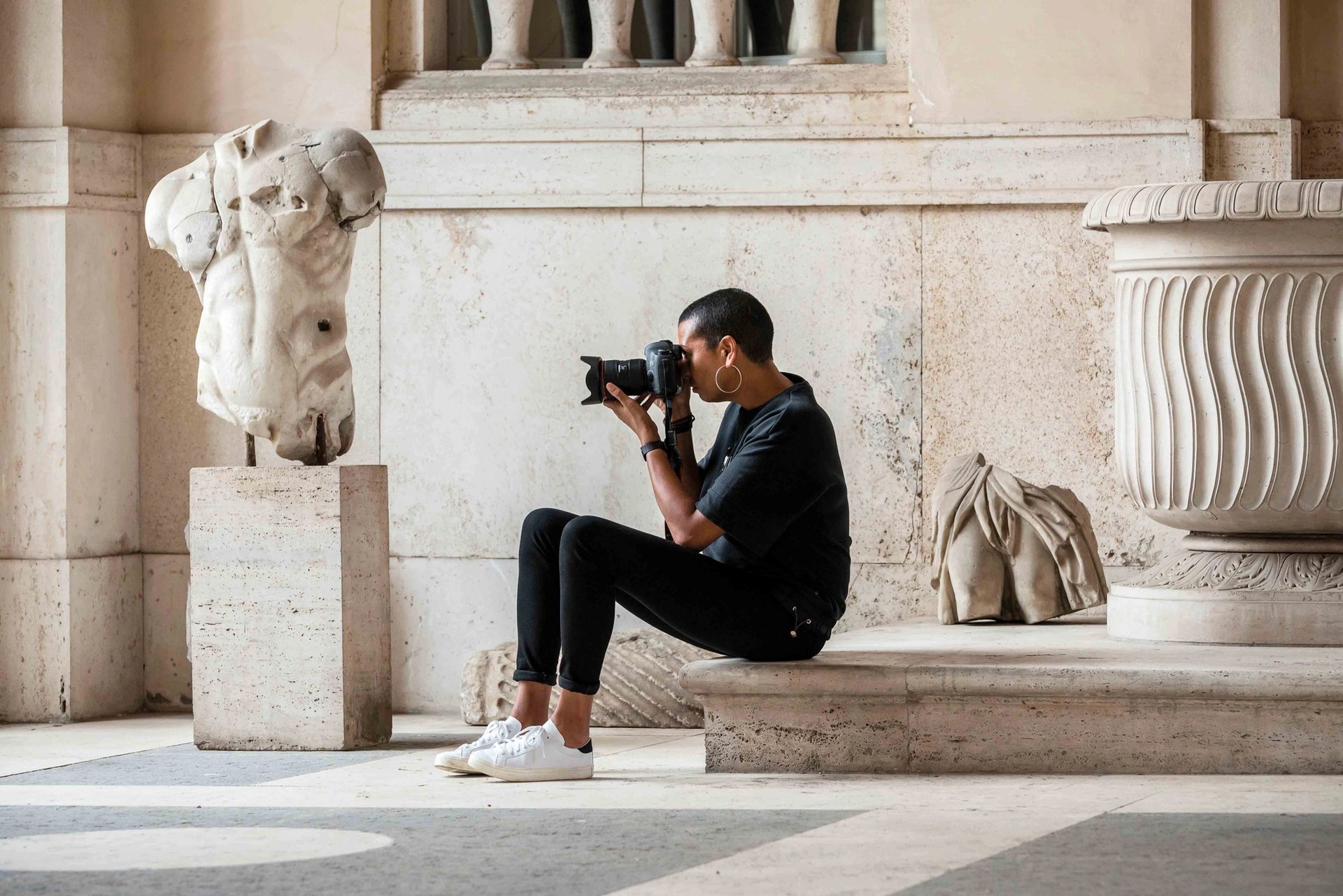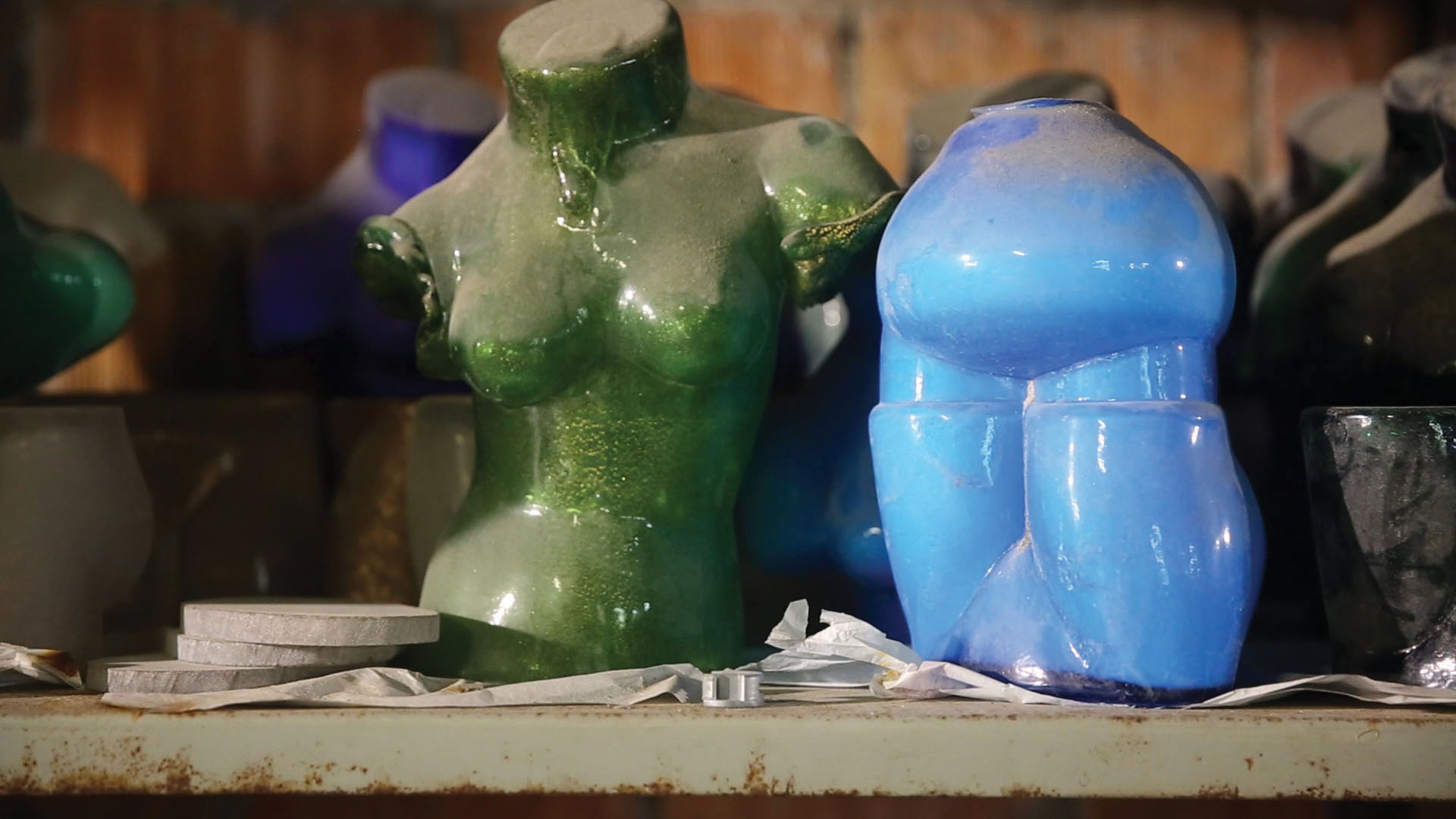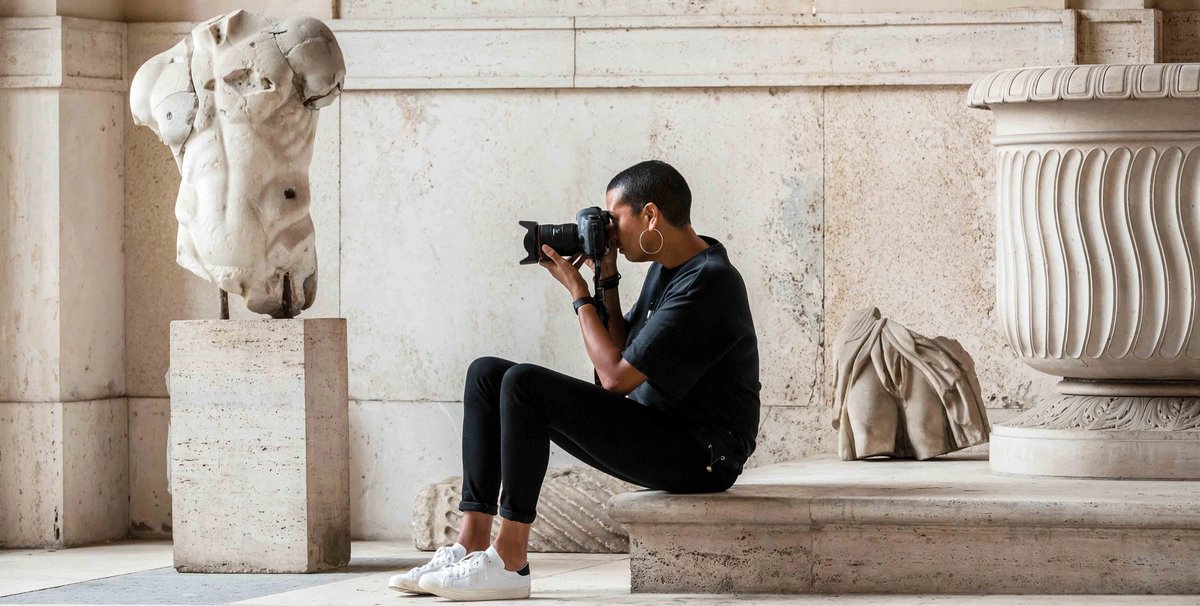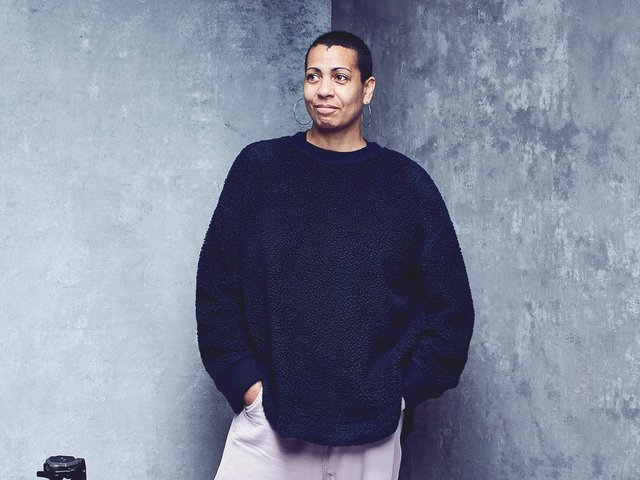
After winning the Max Mara Art Prize for Women, Cammock travelled to Italy to study the Baroque period Portrait © Sebastiano Luciano
It has been a whirlwind couple of years for Helen Cammock. She won the Max Mara Art Prize for Women at the Whitechapel Gallery last year and travelled, like all winners of that prize, to Italy to make work for her commission, which opened in June at the gallery. Also last year, she created a major new film, The Long Note, for Void in Derry/Londonderry, which led to a Turner Prize nomination this year. The Turner Prize show, featuring all four nominees, opens at Turner Contemporary in Margate in September.
Cammock uses film, performance and text to explore the present and the past and link stories across time, often involving marginalised people and communities alongside her personal history. In recent videos, she brings archival film together with footage she shoots herself, emphasising the role of distinct people and communities in telling those stories—poets, musicians and writers also feature. She seeks to “wander between voices”, to question authorship and emphasise her subjectivity, and ours as viewers, in interpreting language and images.
We hear Cammock herself frequently in the films—narrating and sometimes singing. “My voice is the carrier of the information that I’m bringing together, to pull new meanings or new stories together through these different voices,” she says. Music runs through her work, and for her Max Mara Prize commission she looked deep into the lives of female composers of the Baroque period.
The Art Newspaper: Did you know before you went to Italy that you were going to look at historical composers?
Helen Cammock: They were my starting point. I had been to Italy perhaps once in my life, and so I didn’t really know what to expect. And I’ve been interested in thinking about the voice; I’m very interested in music, so music and song come into performance for me, but also into the films that I make. I decided to look at Italian culture and music, and really got completely pulled in by the Baroque period. That was my starting point, and informed where I went initially on the residency. But it also informed me in falling back and looking back through the way that I’ve been working—and something that kept coming up over and over again was lamentation and the idea of lament.
You’ve focused on two particular women composers.
Yes, Barbara Strozzi and Francesca Caccini. And I have to be honest: it was because I was completely transfixed by the music. There’s no other starting point for me. I felt something when I heard music by both those composers. More importantly, I suppose, I am really interested in jazz and the blues. They recur in my performances but also in my film work. I could hear jazz in Baroque and I could hear blue notes. It’s to do with the scaling, but it’s also to do with the way that the music’s constructed.
Throughout your work you’ve investigated the under-represented in cultures, in a very broad range of locations and conditions. Are these two composers a continuation of that?
It’s interesting because the more research I did, the more I realised how successful both [composers] were at the time. But what’s interesting and what sits really well in the way that I [consider] how histories are built is that they disappeared for many years—centuries, in fact. So that’s the cycle that I’m interested in—who is omitted, when they’re omitted and why they’re omitted—this idea that people are removed from histories. I have this [concept] of multiple histories, and so it’s about building back, interrupting those histories, rewriting them, rethinking them and having conversations about what’s happened for people to be taken out. This idea that they were always obscure and marginalised is actually not the truth; they were successful, they did have a stage and a voice, but somehow, over the periods of history that we’ve experienced more recently, they disappeared.

Cammock's film Chorus was inspired by the Baroque period. The film formed part of the show Che si può fare Chorus: Courtesy the artist © Helen Cammock
Obviously you’re not making a historical documentary so how have you brought these figures into the present?
The biggest challenge for me is one I, perhaps foolishly, gave myself: the proposition that I would have some classical singing lessons. I’ve never had any singing lessons in my life before; I use the voice, I do spoken word and song, but I’m not a singer. I enjoy singing and it becomes a part of what I do. So the challenge was to think about how I could somehow allow this music to sit inside me. The thing that I’m most interested in is this idea that stories and lives can cross time and geographies, and there are connections that can be made between people and experiences that don’t have to be about an immediate understanding or knowledge or connection. So that explains this idea that I would try and sing something so [far] outside of my own experience.
You’ve had singing lessons, you’re doing performances at the Whitechapel with a jazz trumpeter and you’ve produced a vinyl record as well.
Yes. Obviously I knew that I couldn’t stand in a room and perform a classical piece of music as a classical singer, because that’s not who I am. So I’m singing Che si può fare [by Barbara Strozzi], a pre-opera lament. I’ve learnt it and I’ve practised it and I’m singing it as me; it’s my voice, and my voice is vastly improved from having singing lessons, but I am still not a singer. And one of the things that I was really excited about was the relationship between voices coming together—the idea of conversation and dialogue—so it made sense to invite another instrument to be in dialogue with the voice. I used to play the trumpet as a child so it’s an instrument I’ve always loved; the first record I ever bought was a Louis Armstrong record. So there’s something that resonates with me in the tone of a trumpet.
It’s also an instrument that’s come up on a number of occasions in the research that I’ve conducted in Italy. One of the stories that features in the film was about a nun who was also a composer, Lucrezia Vizzana, and she wrote the most incredible music. She was part of a monastery that had a male section and a female section. In their monastery they played and composed music, and they became famous in the area around Bologna. Crowds would come not necessarily for prayer, but to celebrate the music that she composed. This proved to be a challenge, not just to the papal structures that were in place but also in terms of gender—with the male and the female side in the monastery. There were many, many issues that came up... in the end the Pope banned them from playing trumpets because it was seen to be unseemly to play an instrument that they put into their mouths.
The story comes into the film a little bit, but basically the nuns refused and carried on playing trumpets and carried on singing, and in the end the papal troops were sent in and they were starved into submission. Lucrezia stopped writing music, she stopped singing, they stopped playing and the story is that perhaps she lost her mind. So it’s a sad story. But the trumpet for me then needed to be there. The duet happens between a classical piece of music, a classical voice—although it’s my voice—and a jazz trumpeter.
Does this idea of lament appear in the contemporary stories in the film as well?
Absolutely. The film is almost like a wave that crosses histories and times; it moves from having interviews to having poetic texts to having song to having music. But the interviews are about moments where I’m having conversations with people. For example, I met a 92-year-old who had been a teenage partisan fighter; she was part of a core where they sabotaged aircraft in a factory where she worked. I spoke to her for nearly three hours, so to reduce it down was really difficult. The stories that she told were stories of lament, but they were also stories of resistance and resilience and a sense of longing, as well.
How much can art play a social role and a role in creating another kind of dialogue in a very fractious moment?
I suppose the thing that’s most interesting about art for me is the potential for transformation, whatever that’s about—the potential for something to become something else. If you’re thinking about social change or political change or moments of crisis, transformation needs to be part of that process, or we’re stuck. So it makes sense to me—it doesn’t mean that every artist has to make work that has a political agenda or has an intent that’s about social change and political change—but we’re engaged in the world that we live in and so that work reflects that and stimulates dialogue, no matter how that’s done. I think it’s really important and it makes sense to me. It doesn’t mean that if you make something beautiful then that can’t also work in a way that stimulates dialogue, which can then be used to talk about other issues. We get stuck in this space where, when we think about social change or the responsibility of art, every single piece of art has to have a political or social underpinning. I’m not adhering to that and I don’t believe that needs to be the case.
Artists find it uncomfortable to be placed in competition with others in the Turner Prize. Do you have to focus on the huge audience rather than troubling yourself with the idea that it’s a prize?
Absolutely. One of the things this year is that the other three artists and I have been having discussions about how important it is that we consider the idea of a group show, the idea that there’s something collegiate that’s happening. We’ve been talking about the relationships between our work because, fundamentally, the idea that we’re in competition with each other for a prize is really because there aren’t enough opportunities for artists in the UK. And that’s the thing that’s frustrating about it. We shouldn’t be in competition because we work in very different ways and actually there should be enough space for everybody to be working and thinking and progressing in a way that’s not about trying to be the best or be ahead or seen more fully than the next person. But unfortunately when opportunities are quite lacking, that’s what happens. And so how we’ve been thinking about it and talking about it is trying to somehow interrupt that and do it differently. We have our own spaces, because that’s the way it works, but we’re talking about how, in the overall sense and feel of the show, we speak to each other. We want there to be a dialogue and a conversation.
Key work
The Long Note (2018)
The work that led to Cammock being shortlisted for the Turner Prize, The Long Note, is a more than two-hour-long film focusing on the role of women in the civil rights movement in Northern Ireland. “Initially I was slightly anxious about it because normally it’s quite important that I have some experience of what I am making the work about,” she says. But Mary Cremin, the director of Void gallery in Derry/Londonderry, who commissioned the work, as well as being clear she wanted a woman to make it, “was really interested in the approach of somebody who might come from the outside and look in, and start having conversations with people who were outside of them having their own experience or their own agenda”, Cammock says. She typically reflected multiple perspectives on this pivotal moment in the history of the city, and drew connections with the Civil Rights movement in the US.
• Che si può fare, Whitechapel Gallery, London, until 1 September; Collezione Maramotti, Reggio Emilia, 13 October–16 February 2020
• Turner Prize 2019, Turner Contemporary, Margate, 28 September-12 January 2020



